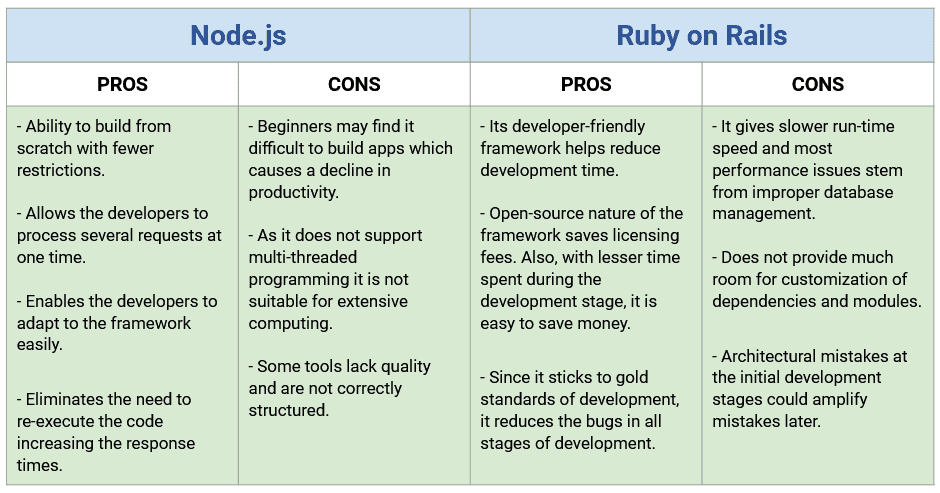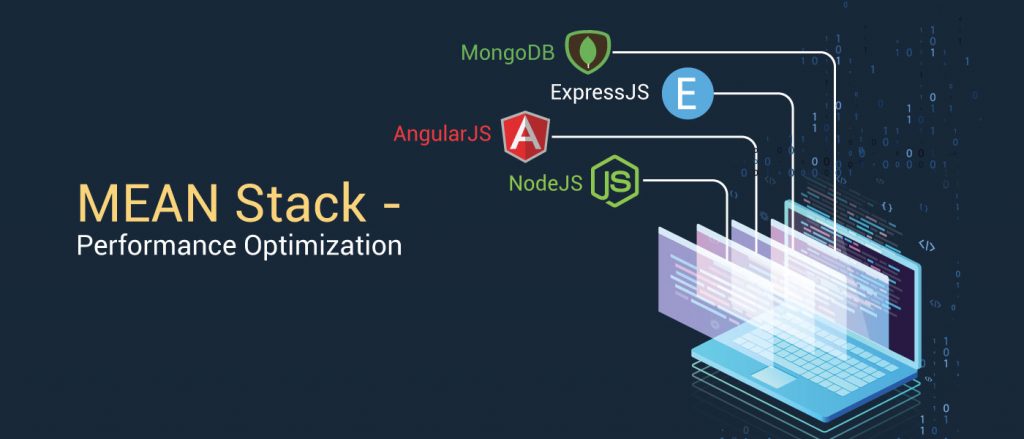Node.Js Vs Ruby On Rails: Diving Deeper Into The Popular Backend Frameworks
Digital presence is no longer confined to a static website. The advent of backend frameworks has helped raise the standards of web development. The backend frameworks are an important aspect of web development. These frameworks help in creating necessary online platforms and applications. Finding a suitable framework that ensures utmost scalability and performance is the key to a successful business.
However, with many choices available in backend frameworks, finding one that suits a specific business goal can be challenging. This is why we want to help you dive deeper into the popular backend frameworks so you can make the right choice. Here is an unbiased comparison of two popular and trusted backend frameworks: Node.js and Ruby on Rails (ROR).
An Overview Comparison of Node.js and Ruby on Rails
Node.js
Node.js is a server-side open-source tool. It attributes its success to the single-threaded process used for web loads and async programming. Businesses can also use Node.js-based frameworks to enhance the backend capability of a project. This technology can build single-page applications, websites, and backend API services.
Market Stats Of Node.Js
- 66.8% expressed interest in continuing to develop with Node.js frameworks.
- A survey revealed that 85% of Node.js developers use it for web app development.
- There also has been 3.5% of stack overflow questions addressed regarding Node.js a month.
Node.js Use Cases
- Nasa: By creating a single database for any query, Nasa could reduce access time by 300%.
- Netflix: When they migrated from Java to Node.js, they decreased their startup time from 40 minutes to 60 seconds.
Read more: Learn why Fingent is recognized as a Top Node.js Company by TopDevelopers.co!
Ruby on Rails
Ruby on Rails is an open-source web application framework written by Ruby. It is the best option for beginners to help them build and deploy web applications and websites.
Market Stats of Ruby on Rails
- Ruby on Rails powers 394,000 websites
Ruby on Rails Use cases
- GitHub: GitHub has over 61 million repositories for its 22 million users worldwide. Using Ruby on Rails, they improved performance, documentation, and features.
- Airbnb: Airbnb boasts over 7 million listings in over 220 countries and regions. Ruby on Rails enabled them to reduce the TTM.
Pros and Cons of Node.js and Ruby on Rails
Now that we understand the pro and cons, let us look at a few other comparisons.
Performance and Speed
Performance is important when building complex and large projects.
Node.js creates the perfect environment for small tasks that do not affect the main application thread. Plus, the JavaScript engine can make multitasking more efficient.
Ruby on Rails can create efficient web applications with satisfactory performance. RoR applications may slow down in rare cases, like when the traffic scales significantly.
Application Architecture
It is important to choose flexibility when choosing a framework. A framework should be a guide, not a standard.
Node.js enables developers to handle multiple concurrent requests with high performance. in addition, it supports asynchronous communication between various components providing high performance. It ensures faster, flexible development modules and reduces time to market.
Ruby on Rails, on the other hand, follows MVC architecture. This architecture easier testing and decoupling because of the convenient separation of concerns. Also, since it follows the conventions of the configuration principle, it reduces developers’ legwork.
Scalability and Ease of Testing
Backend frameworks significantly influence web application scalability and ease of testing.
Node.js builds highly-scalable applications, and the event loop mechanism enables the server to process maximum requests. It is highly compatible with microservices. Hence, development teams can build applications more quickly as they scale. Node.js offers competent testing and debugging capabilities.
It is possible to scale with ROR if you invest more resources than other leading backend frameworks. However, Inadequate memory management and poor concurrency can create issues when trying to scale quickly on the ROR platform. Testing is simple and effective in ROR, considerably reducing intricacies during the testing phase.
Microservices Compatibility
Node.js builds smaller parts of services and code modules to efficiently handle multiple concurrent requests. Hence, Node.js and Microservices are an absolute combination for building enterprise-grade complex applications with higher scalability.
Though Ruby on Rails leans on monolithic architecture, it can be used in a microservices architecture. Hence, it is compatible with microservices’ needs and deployments.
Database Support
Node.js supports all kinds of databases. However, it is better to use a NoSQL database as it stores data in JSON objects because it offers more accessibility to Node.js.
Ruby on Rails comes configured for SQLite. However, it allows the use of multiple databases.
Hiring The Best Developers
The large community of Node.js and Ruby on Rails makes it easy to hire developers. If you are considering a backend tool for your project, Fingent top custom software development company can help define your project priorities to help you choose the stack that fits your needs.
Read more: How we optimized a MEAN Stack project for better performance
Fingent provides you with top performing talent pool for all your development needs for both these frameworks. If you struggle to choose, our elite consultants will help you find the right framework that suits your business goals.
Reach out to us, and let’s talk about what that is.
Stay up to date on what's new

Recommended Posts

21 Nov 2022 B2B
Why App Modernization Projects Fail – The Secret To A Successful App Modernization Project Journey!
Modernization is a desire to stay relevant and grow. App modernization does just that for businesses. It enables them to stay relevant and grow. In line with that, organizations worldwide……

04 May 2022
Web Application Development: A Detailed Guide for 2022
Web Application Development: A Detailed Guide for 2022 Web Application is the first line of contact between your customers and business. Let’s Discuss Your Project Table of Contents What is……

31 Jul 2021
Web Application Development: A Detailed Guide for 2021
A comprehensive guide to web application development in 2021 Introduction What is a Web Application? What is Web Application Development? Web Apps vs Mobile Apps Types of Web Applications……

20 Aug 2020 Healthcare
5 Transformative Trends Ushered by B2B E-commerce in Healthcare and Life Sciences
How e-commerce adoption benefits B2B healthcare providers and device makers The healthcare and life sciences industry is expanding at an exponential rate. The complexity and regulatory nature of the industry……
Featured Blogs
Stay up to date on
what's new












